Add a Comment
Viewing: Blog Posts Tagged with: trail, Most Recent at Top [Help]
Results 1 - 10 of 10
Blog: Scribble Chicken! Art and Other Fun Stuff (Login to Add to MyJacketFlap)
JacketFlap tags: illustrator, children, publisher, children's books, Illustration, adventure, cute, book, nature, outdoors, weird, Cowboy, painting, child, children's book, silly, cat, grow, vintage, desert, trail, horse, outside, Kitten, costume, publish, Pony, strange, growth, ride, feline, outdoor, riding, Oil Style, horse back riding, Add a tag
Blog: DIANE SMITH: Illo Talk (Login to Add to MyJacketFlap)
JacketFlap tags: illustration, illustration friday, drawing, pen and ink, doodle, sketchbook, trail, Add a tag
Lots going on this week and I didn't think I would be able to get anything done. But, then I remembered I had this bear drawing from a couple years ago - PERFECT!
Blog: ValGal Art (Login to Add to MyJacketFlap)
JacketFlap tags: trail, ValerieGallerie.com, Topanga Box, hand painted box, Illustration Friday, Valerie Walsh, Add a tag
Blog: A Mouse in the House (Login to Add to MyJacketFlap)
JacketFlap tags: illustration, Illustration Friday, IF, children's illustration, little red riding hood, digital art, roberta baird, artwork, trail, houston, a mouse in the house, wolfe, Into the Woods, Add a tag
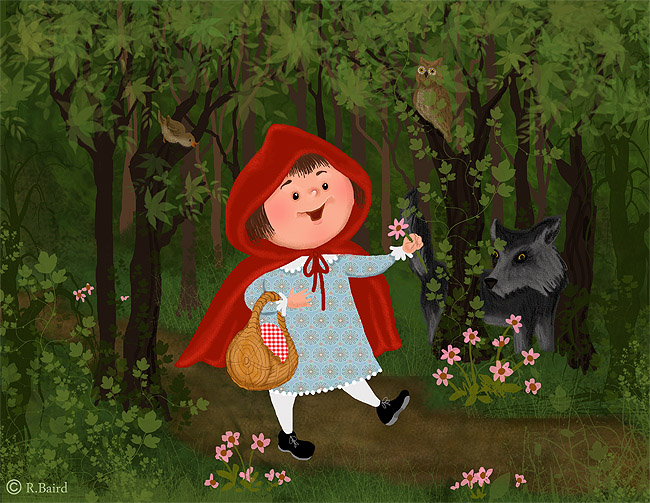
Into the woods, It’s time to go,
I hate to leave, I have to, though.
Into the woods- It’s time, and so
I must begin my journey.
Into the woods And through the trees
To where I am Expected ma’am,
Into the woods
To Grandmother’s house-
Lyrics by Stephen Sondheim for Into the Woods
Blog: blog 30 x 30 - Chuck Dillon's blog. (Login to Add to MyJacketFlap)
JacketFlap tags: illustration friday, trail, Add a tag


Blog: OUPblog (Login to Add to MyJacketFlap)
JacketFlap tags: ben, A-Featured, Ben's Place of the Week, dirt, haiti, sisal, foodstuff, oupblog, Geography, “authentic”, tofu, hinche, trucked, keene, Serial Blogging, maps, Add a tag
Coordinates: 19 9 N 72 1 W
Population: 23,599 (2003 est.)
People travel for many reasons, but a chance to sample local or “authentic” cuisine often weighs heavily in the decision-making process. In my own peregrinations I’ve sampled stir-fried insects in Thailand, whale carpaccio in Norway, and stink tofu in Taiwan: all things that are harder to come by in the U. S. of A. An uncommon foodstuff that I haven’t tried however, can be purchased for next to nothing in the impoverished Caribbean nation of Haiti. (more…)
Blog: The Art of Phyllis Hornung Peacock (Login to Add to MyJacketFlap)
JacketFlap tags: tapia, california, hiking, malibu, los angeles, trail, hike, topanga, piuma, malibu creek, hiking, los angeles, trail, hike, topanga, malibu, piuma, malibu creek, Add a tag
I know some time ago I mentioned that I could probably do a blog just about hiking and I guess I really wasn't kidding. So, because a good half of my blog focuses on hiking, I thought I'd add the word "hiking" to the subtitle. Anyway, my husband had the last week off work and I got absolutely no work done, but, naturally, we did do quite a bit of hiking . On Monday, we went to Topanga State Park and hiked the Santa Ynez Canyon Trail. The trail starts out high up in the hills and gradually winds down into a heavily wooded canyon. Taking a left at a fork in the trail, the path leads to a waterfall. We strayed off the beaten path a bit and followed the stream, boulder-hopping to reach the waterfall. At one point in the creek, the boulders are just high enough that we needed to use some knotted ropes that had been left there to help pull ourselves up to higher ground. The waterfall was no more than a trickle just like every waterfall we've encountered this summer, but unlike the many creek-beds we've seen, this one did run with water.
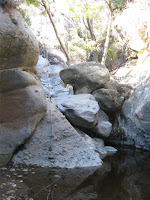 Taking the same trail, we made our way back to the car. As we came over the crest of the last hill, the land opened out into dry, grassy meadows. We spotted a lone deer grazing not too far away. I tried to get as close to it as I could without alarming it, shooting pictures along the way. When that deer disappeared from view, we continued on our way, but stopped again shortly when we heard something sizeable crashing through the brush. Another deer came into view! And another and another - a herd of eight deer in all wandered out from the cover of forest into the open
Taking the same trail, we made our way back to the car. As we came over the crest of the last hill, the land opened out into dry, grassy meadows. We spotted a lone deer grazing not too far away. I tried to get as close to it as I could without alarming it, shooting pictures along the way. When that deer disappeared from view, we continued on our way, but stopped again shortly when we heard something sizeable crashing through the brush. Another deer came into view! And another and another - a herd of eight deer in all wandered out from the cover of forest into the open
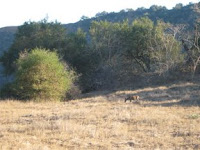 meadow. We shot many photos, but the deer were so well camouflaged that they are difficult to see in the photos. When they finally slipped out of view, we made our way through a live oak grove back to the car. We'd been so tired from the long hike, but after we paused and watched the deer for a while we felt energized all over again. It's so exhilarating to see wildlife in their natural habitat.
meadow. We shot many photos, but the deer were so well camouflaged that they are difficult to see in the photos. When they finally slipped out of view, we made our way through a live oak grove back to the car. We'd been so tired from the long hike, but after we paused and watched the deer for a while we felt energized all over again. It's so exhilarating to see wildlife in their natural habitat.
Malibu Creek
On Friday we went hiking again, this time we started out at the parking lot for Piuma Ridge. There seemed to be endless little side-trails that led to who-knows-where. We made our way north, entered into a smallish live oak grove, and got a glimpse of a water reclamation facility. After nosing arou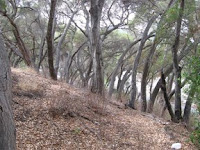 nd for
nd for 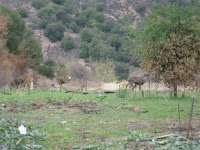 a bit, we decided to try to find our way through Tapia Park and into Malibu Creek State Park, intending our final destination to be the Mott Adobe Ruins. We took a trail that seemed logical, but turned into a dead-end at a locked gate. So we had to double back, find a trail not marked on the map and carefully pick our way across a narrow strip of the creek. We had
a bit, we decided to try to find our way through Tapia Park and into Malibu Creek State Park, intending our final destination to be the Mott Adobe Ruins. We took a trail that seemed logical, but turned into a dead-end at a locked gate. So we had to double back, find a trail not marked on the map and carefully pick our way across a narrow strip of the creek. We had 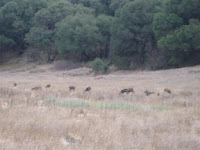 made it into Tapia and ended up hiking right next to a long road/parking lot which then ended abruptly at a camp. According to the map we had, the camp appeared to have been plunked down right in the middle of the road we wanted to take and of course it was gated, so the desirable road was completely off-limits. We were so lost we even asked for help. Unfortunately the person we asked wasn't all that familiar with the trails, so we took a guess at which trail to take. And we guessed right! We took a segment of the Backbone Trail that traversed up the side and over a mountain right into Malibu Cre
made it into Tapia and ended up hiking right next to a long road/parking lot which then ended abruptly at a camp. According to the map we had, the camp appeared to have been plunked down right in the middle of the road we wanted to take and of course it was gated, so the desirable road was completely off-limits. We were so lost we even asked for help. Unfortunately the person we asked wasn't all that familiar with the trails, so we took a guess at which trail to take. And we guessed right! We took a segment of the Backbone Trail that traversed up the side and over a mountain right into Malibu Cre ek State Park. Not too far into the park, we spotted six deer grazing on a patch of green grass. We were as close as we'd ever been to the creatures and shot a lot of photos. The buck seemed to become a bit unnerved by us and bounded gracefully away across the road. It was as if he was telling his herd that he wasn't terrified, but thought it best to move on. The rest of them seemed unperturbed, but gradually followed him. We did finally come across the Mott Ruins. There wasn't much left of them, save the chimney. It seemed a bit of a disappointment after spending much of the day being lost in trying to find it. On the way back we crossed a broad meadow were a whopping fifteen deer were grazing. This sight alone made the trek well worth while!
ek State Park. Not too far into the park, we spotted six deer grazing on a patch of green grass. We were as close as we'd ever been to the creatures and shot a lot of photos. The buck seemed to become a bit unnerved by us and bounded gracefully away across the road. It was as if he was telling his herd that he wasn't terrified, but thought it best to move on. The rest of them seemed unperturbed, but gradually followed him. We did finally come across the Mott Ruins. There wasn't much left of them, save the chimney. It seemed a bit of a disappointment after spending much of the day being lost in trying to find it. On the way back we crossed a broad meadow were a whopping fifteen deer were grazing. This sight alone made the trek well worth while!
Temescal Canyon
So then yesterday we went back to Topanga State Park and hiked Temescal Canyon Trail which is on the southern side of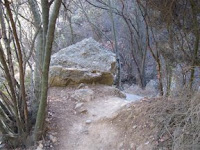 the park in Malibu. It was a really beautiful location, but it was just full of people - probably the most we've ever encountered during a hike. With all the people there was no chance of encountering wildlife. The trail leads out to a meager California waterfall and then loops back to the parking lot switch-backing along a mountainside. At the top of the mountain, there's a path that traverses the ridge and ends at Skull Rock. Usually look-out points in these various parks offer sweeping views of the ocean or more mountains, but this trail featured views of the city. Very pretty, but a bit too busy.
the park in Malibu. It was a really beautiful location, but it was just full of people - probably the most we've ever encountered during a hike. With all the people there was no chance of encountering wildlife. The trail leads out to a meager California waterfall and then loops back to the parking lot switch-backing along a mountainside. At the top of the mountain, there's a path that traverses the ridge and ends at Skull Rock. Usually look-out points in these various parks offer sweeping views of the ocean or more mountains, but this trail featured views of the city. Very pretty, but a bit too busy.
On a more artistic note, last night we watched the anime movie Tekkonkinkrete. Even if you're not really into anime it's definitely worth a watch for the backgrounds alone. They are just stunning. I would never in a million years have the patience to paint such amazingly detailed backgrounds. Wish we'd caught it on the big screen...
Read the rest of this post
Blog: The Art of Phyllis Hornung Peacock (Login to Add to MyJacketFlap)
JacketFlap tags: hiking, malibu, hiking, los angeles, trail, hike, malibu, Point Mugu, los angeles, trail, Point Mugu, hike, Add a tag
I know I just wrote in my last post that we weren't going to go to Point Mugu until October so we could catch the sycamores in their full glory, but we've sort of run out of coastal parks to visit, so this past weekend we caved in hiked part of Point Mugu. It's gradually getting cooler, but it's still just warm enough to prevent us from doing some of the more inland hiking. Fortunately, Point Mugu is a huge park, so we'll likely come back to hike more of the trails and maybe we'll get another glimpse of the sycamores.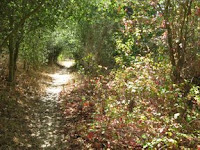
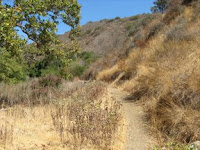
So we started up Big Sycamore Canyon Trail, thinking we'd try to keep to the shade that canyon trails usually offer and then we took a right a a fork in the path onto the Serrano Canyon Trail. It was a good choice as the trail was heavily wooded for a long way and offered much shade. Eventually, the trail 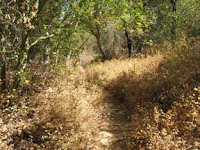
 winds up out of the canyon and opens onto a vast, grassy meadow surrounded by mountains on all sides.
winds up out of the canyon and opens onto a vast, grassy meadow surrounded by mountains on all sides.
I generally think that I prefer hiking through woods, but I always find myself so contented trekking through open grassland li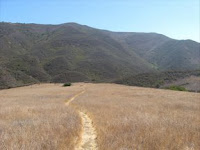 st
st ening to the wind rustle through the dry grass - it's one of my favorite sounds.
ening to the wind rustle through the dry grass - it's one of my favorite sounds.
The trail began to climb up out of the valley, back into the mountains. We took a left at another fork in the road, thinking this narrow path would take us back to the main fire road. As it turned out, we were very much off-the-beaten-path on what resembled a deer path cut through dense short, woody trees. My bare arms took quite a lashing from those dry branches. A machete would have been very handy at this point! We continued on the trail despite misgivings just to see where it would take us and ended up on a promontory with a great view, but no way down to the fire road. So we had to make our way back through the brush to the more well-worn trail. After quite a bit more trekking we made it back to the fire road. We still had another two or three miles to go to get back to the parking lot and we were pretty tired already. But, at least the fire road was pretty flat - no major hills to climb. I think this was our longest hike yet. I'm estimating it at seven or eight miles. We were really feeling it by the end! I really liked this park - maybe we'll come back and hike a little more of it next weekend!
Blog: OUPblog (Login to Add to MyJacketFlap)
JacketFlap tags: Health, History, UK, smith, beauty, green, A-Featured, virginia, Leisure, purity, clean, dirt, ecology, hot, springs, asceticism, skincare, virginity, baths, Add a tag
Yesterday you read an extract from Virginia Smith’s new book Clean: A History of Personal Hygiene and Purity. For today’s post she has kindly agreed to answer a few questions about her work.
OUP: How did you come to write a book on personal hygiene? (more…)
Blog: OUPblog (Login to Add to MyJacketFlap)
JacketFlap tags: Health, History, UK, smith, green, A-Featured, virginia, Leisure, hygiene, purity, clean, cosmetics, dirt, dirty, makeup, ecology, hot, springs, asceticism, virgins, Add a tag
I’m happy to confess here and now that I’m a girl who likes her mascara, and it’s a rare day that I appear in public without it. So, imagine my delight when our new book Clean came along. In it the author, Virginia Smith, explores the development of our obsession with personal hygiene, cosmetics, grooming, and purity. In the first of three posts, I’m happy to present the below short extract from the first chapter of the book.
Dirt is only matter out-of-place and is neither ‘good’ nor ‘bad’. Nature does not care what we think, or how we respond, to matter in all its forms. But as a species we do care, very deeply, about our own survival. A dense mass of human history clusters around the belief that dirt is ‘bad’, and that dirt-removal (cleansing) is always ‘good’. The old Anglo-Saxon word ‘clean’ was used in a wide variety of situations: it was often blatantly human-centred or self-serving in a way we might call ‘moral’; but it was also used more objectively as a technical term, to measure or judge material things relative to other things. It was thoroughly comprehensive, and unquestioned.
Preceding all human cultural history however – certainly before any human history of personal hygiene – were billions of years of wholly a-moral species development. The exact date one enters this endless time-line is almost irrelevant; what we are really looking for are the time-spans or periods when things speed up, which in the case of homo sapiens was somewhere between c.100,000-25,0000 BCE, followed by another burst of development after c.5000 BCE. Throughout this long period of animal species development, all of our persistent, over-riding, and highly demanding bio-physical needs were evolving and adapting, and providing the basic infrastructure for the later, very human-centred, psychology, technology and sociology of cleanliness.
It is difficult not to use ancient language when describing the egotistical processes of human physiology – routinely described as  the ‘fight’ for life – and in particular, our endless battle against poisonous dirt. Much of this battle is carried out below the level of consciousness. Most of the time our old animal bodies are in a constant state of defence and renewal, but we feel or know nothing about it; and the processes are virtually unstoppable. We can no more stop evacuating than we can stop eating or breathing – stale breath, of course, is also an expellation of waste matter. Ancient scientists were strongly focussed on the detailed technology of these supposedly poisonous bodily ‘evacuations’; and modern science also uses similarly careful technical terminology when describing bodily ‘variation’, ‘elimination’, ‘toxicity’ or ‘waste products’. In either language, old or new, inner (and outer) bodily ‘cleansing’ is ultimately connected to the more profound principle of ‘wholesomeness’ within the general system of homeostasis that balances and sustains all bodily functions.
the ‘fight’ for life – and in particular, our endless battle against poisonous dirt. Much of this battle is carried out below the level of consciousness. Most of the time our old animal bodies are in a constant state of defence and renewal, but we feel or know nothing about it; and the processes are virtually unstoppable. We can no more stop evacuating than we can stop eating or breathing – stale breath, of course, is also an expellation of waste matter. Ancient scientists were strongly focussed on the detailed technology of these supposedly poisonous bodily ‘evacuations’; and modern science also uses similarly careful technical terminology when describing bodily ‘variation’, ‘elimination’, ‘toxicity’ or ‘waste products’. In either language, old or new, inner (and outer) bodily ‘cleansing’ is ultimately connected to the more profound principle of ‘wholesomeness’ within the general system of homeostasis that balances and sustains all bodily functions.
Further extracts from other chapters of Clean can be found on Virginia Smith’s website.





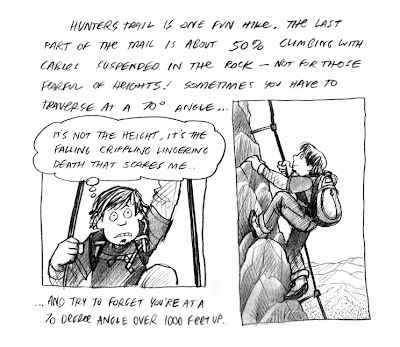
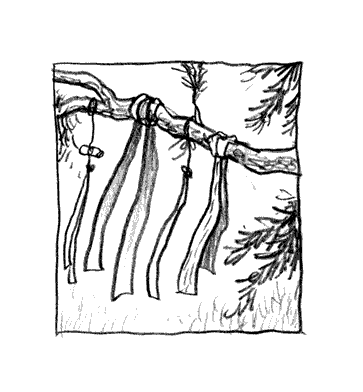


Wow that's so cool! What a great idea and what a wonderful way to re-use something - fantastic!
I love the colours and the tone of the paint - lovely
Lovely and peaceful
Your box positively glows, Valerie. What a nice idea and tie-in to the prompt. I, too, am a walker and it always manages to refresh me.
this is lovely
Beautiful!
I want. Awesome idea.
I'm sure there's a star inside
:D
Beautiful!
:-)
Love this Val, what a gorgeous shade of blue!! I love my walks too (altho it's so hot & humid here in south Texas lately, I've taken to indoor walking)
Hope you are well my friend :)
Very beautiful skyline and I can feel the silent night.
I want to watch the star this way. So fulfilling!
Original idea for the Trail prompt, Val! It's a beautiful box and I'd like to peek inside!
blue hills in a blue sky ... what a wonderful world you created with your work!!!
Thanks for visiting my blog, I'm always so happy to see a comment from you :o)
Wow, this is beautiful, Val! :)
Simply magical Val.... now I'm wondering what's inside!!
WOW! Nice.Your work is truly beautiful.
beautiful painting valerie! it is simple but very attractive. and i discover one thing we both like ---walking :)
This magical blue box seems peaceful and gentle and calming. I wonder what is inside?
A shining star? A glass egg? A magic jewel? A magic genie?
Makes me wonder.
inside...hmmm....
a very sweet little custom die-cut val pal gift tag, perhaps?
The blue of the box Val is so striking it really looks like it glows.
Gorgeous! What a lovely submission to IF and a really great piece of work. I love seeing how artists work on different "canvases" especially when it is recycled.